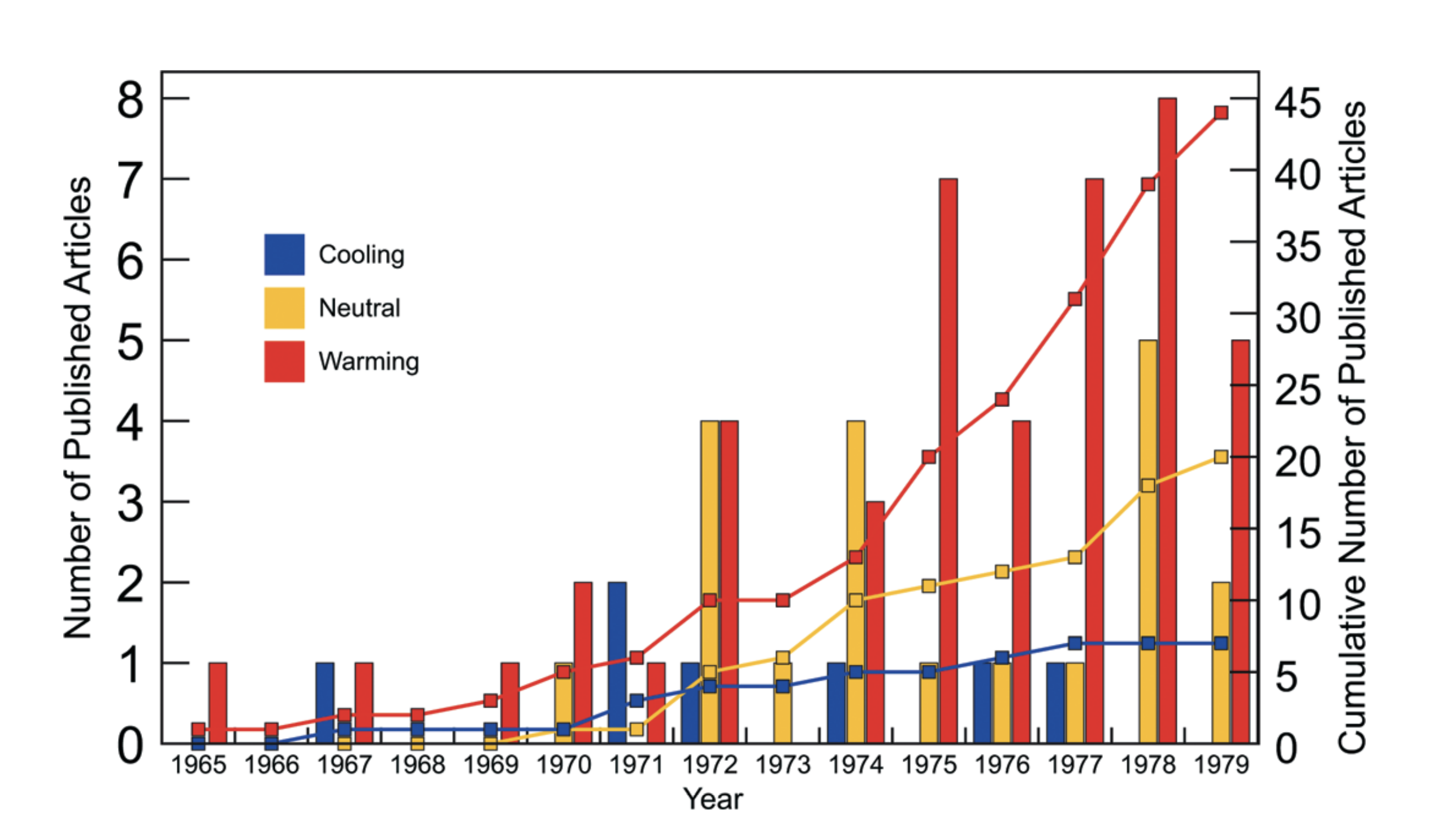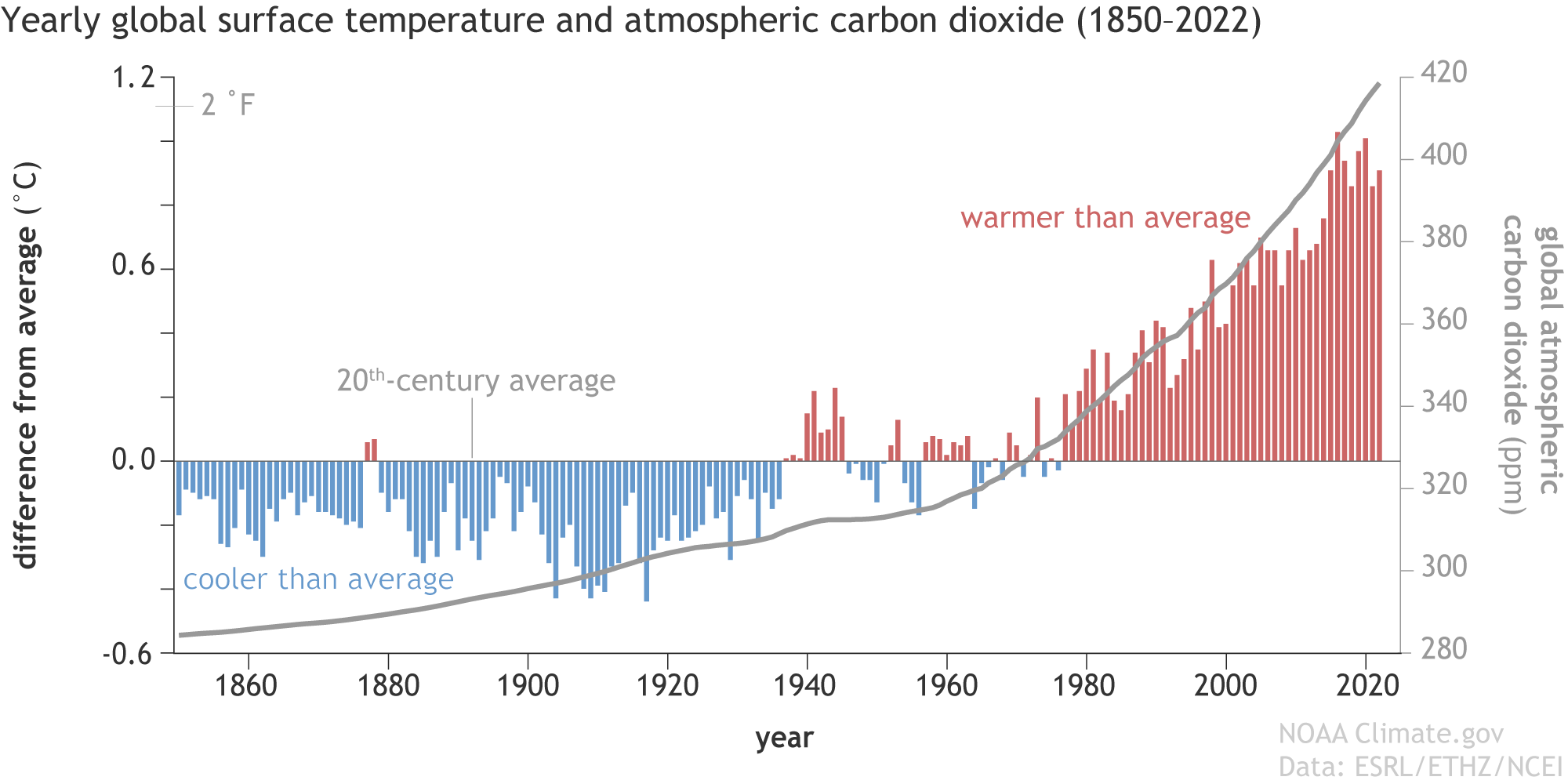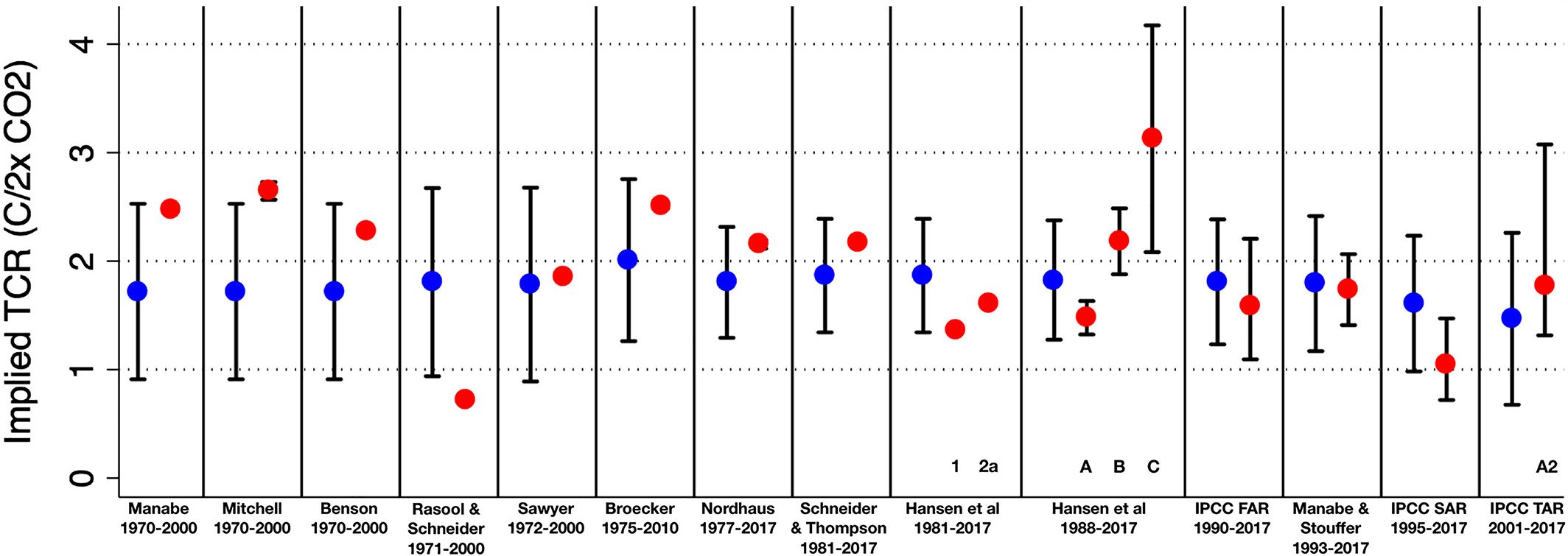

REVIEW
CLAIM: Scientists in the 1970’s predicted there would be global cooling and a new ice age in the coming decades, but they were wrong. This means they are wrong again about present and future global warming.
In the 1970’s, some popular media outlets were reporting on the supposition that a new ice age could be coming in the following decades. Of course, this never came to pass. We are now in the midst of rapid global warming, largely due to anthropogenic emissions of greenhouse gasses. Multiple temperature records indicate an increase in average global temperature of at least 1.1°C since record keeping began in the second half of the 19th century.
However, these historical popular media reports are often used today to challenge global warming and climate change science. In social media posts such as the one featured below in Box 1, it is claimed that because some scientists were studying the possibility of a global cooling that did not end up happening, science must be wrong today about global warming.
But scientists in the 1970’s were not entirely certain that global temperatures would increase or decrease in the coming decades. Global warming due to elevated greenhouse gasses was already being modeled, but new research indicating the potential cooling effects of atmospheric aerosols made it necessary to study whether their cooling effect or the warming effect would dominate in future climate change. That said, more scientific studies were forecasting a future warming than a cooling during the 1970’s. A scientific consensus was eventually reached on the fact that the warming influence of greenhouse gasses dominates the cooling effect of aerosols.
There was no scientific consensus on global cooling in the 1970’s
The idea that scientists in general were predicting an impending global cooling in the 1970’s is wrong[1]. In 2008, a study investigated whether there was any agreement on this topic in the scientific literature. The authors reviewed scientific studies published between 1965 to 1979 projecting or estimating any aspect of climate change and climate forcing over time scales from decades to a century. Only seven of the papers they found projected cooling, whereas 44 projected warming and twenty either projected no change or did not provide an estimate at all (noted as ‘Neutral’ on Fig. 1).

Figure 1 – Papers published during the period from 1965 to 1979 classified as projecting, implying, or providing supporting evidence for future global cooling or global warming[1].
The cooling papers also received less citations in the years immediately following publication, indicating less scientific impact and validation as climate science advanced. British meteorologist John Sawyer’s 1972 global warming projection stands-out among the studies reviewed; his projection that the year 2000 would be 0.6°C warmer turned out to be off by less than 0.1°C[2] (see also Fig 3).
The lack of scientific consensus on global cooling in the 1970’s is also confirmed in a national survey of scientists in the United States called “Climate Change to the Year 2000: A Survey of Expert Opinion”. Following the especially cold 1976/1977 winter in the eastern U.S., 24 leading climate scientists across the country were surveyed in 1978 by the National Defense University and collectively “tended to anticipate a slight global warming rather than a cooling”.
The leading theory on future climate change in the decades before, during, and after the 1970’s has been that of a climate warming due to greenhouse gasses. Ever since the first demonstrations of the greenhouse effect over a century ago and the awareness that humans increasingly emit greenhouse gasses, scientists have consistently warned about global warming. In the defense of the climate scientists who were concerned about a global cooling trend, global temperatures decreased by about 0.1°C from 1940-1970 and it was legitimate to investigate the causes of this trend and whether it would reverse or not.
Atmospheric aerosols from anthropogenic air pollution played an important role in some of the local cooling that was observed (i.e., locally over the industrial areas where they are released). But as air pollution aerosols were reduced, emissions of greenhouse gasses continued, and temperature measurement coverage expanded globally, the cooling trends observed over industrial land areas in the northern hemisphere were no longer significant. By the end of the 1970’s, researchers were beginning to understand that any cooling effects from aerosols, which was one of the main supporting points for global cooling projections, were actually outweighed by the warming effects from the increasing concentrations of atmospheric greenhouse gasses[3]. In fact, the reduction of air pollution aerosols and their cooling effects is now a recognized potential driver of global warming scientists follow closely today.
The claim that scientists have repeatedly predicted false environmental catastrophes since the 1970’s has already been shown to be inaccurate by Science Feedback. One of the original global cooling popular media stories was a piece written by reporter Peter Gwynne in Newsweek in 1975. Today, Gwynne is amazed how his nine paragraphs on page 64 are still “misused and misinterpreted” by popular climate change contrarians to somehow contend with several decades of proven climate science. Gwynne has tried to clear the air, writing “it’s time for deniers of human-caused global warming to stop using an old magazine story against climate scientists” in his Inside Science article entitled “My 1975 ‘Cooling World’ Story Doesn’t Make Today’s Climate Scientists Wrong”. While his article exploring the possibility of a cooling due to aerosol pollution was justified at the time it was published, it would not be anymore given the information that has become available since then.
The reality of global warming projections and observations since the 1970’s
Another important point of context to have in mind is that climate science was advancing in the years leading up to the 1970’s; there was uncertainty on the state of the climate because temperature records at the global scale were lacking. The first satellite measurements were starting by the late 1960’s, but we were not yet sure if temperatures were trending up or down and what the main drivers were. Today, there is overwhelming evidence and scientific consensus that global temperatures are increasing.
We have robust records of air temperatures over land and the oceans worldwide thanks to the efforts of thousands of data collectors, scientists, meteorologists, and other researchers. Various research organizations that record global temperature using different data processing methods have reached the same results: temperature is rising. Efforts to independently and impartially analyze temperature records, on behalf of skeptics, have confirmed their veracity repeatedly.
When we combine temperature records of indirect proxy measurements over the last two millennia (Fig. 2.top), with all the temperature records taken by direct measurements since 1880 (Fig. 2.middle), the increase in average global temperature of at least 1.1°C is clear. There is strong agreement between multiple independent temperature records; they all show that the globe has warmed (in comparison to the average temperature during the period 1951-1980). Compared to the entire 20th century’s average temperature, every decade since the 1970’s have been comparatively warmer (Fig. 2.bottom). This shift from colder to warmer years follows an observed increase in atmospheric-CO2 concentrations, which is the most significant driver of global warming through the elevated greenhouse effect.



Figure 2 – Top: Comparison of temperature record (degrees Celsius) going back in time over 2000 years. Temperature records that are based on indirect proxy measurements are indicated by the blue trendline, while temperature records that were directly measured are indicated by the red trendline (source). Middle: Comparison of consolidated temperature records (degrees Celsius) of multiple datasets and methodologies. The data represents temperature differences (plus or minus numbers on y-axis representing change in degrees Celsius) between the recorded year (x-axis) and a common baseline temperature average for the period 1951-1980 (represented as 0 on the y-axis) (source). Bottom: Yearly temperature compared to the twentieth-century average (red bars mean warmer than average, blue bars mean colder than average) from 1850–2022 and atmospheric carbon dioxide amounts (gray line): 1850-1958 (source).
Beyond demonstrating global warming is real through years of global temperature measurements and global change observations, like sea level rise from melting ice caps and glaciers, scientists have also demonstrated and are in agreement that humans are the main cause of global warming through greenhouse gas emissions like CO2. A recent peer-reviewed scientific study analyzing thousands of other peer-reviewed scientific studies found that 99% of the scientific literature confirms human greenhouse gas emissions cause global warming[4]. Among scientists with the most climate-related expertise, the consensus reaches 100%[5].
In the most recent IPCC report (AR6), the very first text line (line A.1.) of the “Summary for Policymakers” confirms there has been 1.1°C of global warming since the period 1850-1900 and it explicitly identifies CO2 as the leading cause[6]. As an indication of the scientific robustness of AR6, just the contribution from Working Group 1 alone was written by 234 of the world’s leading climate scientists coming from 66 countries. It included nearly 4 000 pages of research based on more than 14 000 scientific papers as supporting references and was critiqued and revised by over 1 500 expert reviewers.
Some of the earliest attempts at using computer models to understand climate change in the 1970’s not only projected warming, they were also reasonably accurate. In a study comparing the projections of seventeen historical climate model projections (seven of which from the 1970’s) with actual temperature observations since 1970, all of the models projected warming and the majority were consistent with reality (Fig. 3)[7]. Only three of the models projected temperature changes there were too far from reality and were therefore incorrect (observations fell outside their ranges of uncertainty): two projected more warming and one projected less.

Figure 3 – Comparison between global climate model projections (red dots) and temperature observations (blue dots). Model projections are expressed as the change in temperature versus the change in radiative forcing, the “implied TCR”, to provide meaningful model-observation comparisons even if the forcing differs between models. As all models have a positive implied TCR value (y-axis), they have all projected an increase in global temperature. The model name and length of time represented are indicated on the x-axis (source).
Box 1. Example of an inaccurate claim that global warming is not real because some scientists once predicted global cooling
In this post on Facebook from 9 December 2023, it is claimed that global warming is a paranoia that climatologists created after their predictions of extreme global cooling leading to a new ice-age did not materialize. The caption of the Facebook Reel lists various statements labeled as “facts”, including the inaccurate claims that “Science is wrong on Global Warming” because “Science was wrong on Global Cooling”. This post has been shared hundreds of times and reached thousands of viewers who may not know that global cooling was not a mainstream climate theory in the 1970’s. As we explained above, there were more scientists at that time projecting and modeling future global warming. In addition, the claim that “Science is wrong on Global Warming” is inaccurate because the reality of global warming has been unequivocal for years, verified by overwhelming observational evidence resulting in the scientific consensus. Hypotheses that were investigated in the past by scientists, like the one on global cooling, do not invalidate today’s proven scientific concepts that accurately represent observed reality, like current global warming.
Conclusion
Some climate scientists in the 1970’s investigated the possibility of a global cooling that they thought could result from the effects of atmospheric aerosols, but the majority of scientists were actually projecting future global warming. In fact, scientists have warned about global warming for a long time. We now know that 1970’s projections of global warming were reasonably accurate, and average temperatures have increased by at least 1.1°C since record keeping began. Overwhelming observational evidence has resulted in the scientific consensus that global warming is real and human activities, primarily through the emissions of greenhouse gasses, is the main driver.
REFERENCES
- 1 – Peterson et al. (2008) The myth of the 1970s global cooling scientific consensus. Bulletin of the American Meteorological Society
- 2 – Sawyer JS (1972) Man-made carbon dioxide and the “greenhouse” effect. Nature
- 3 – Hansen et al. (1978) Mount Agung eruption provides test of a global climatic perturbation. Science
- 4 – Lynas et al. (2021) Greater than 99% consensus on human caused climate change in the peer-reviewed scientific literature. Environmental Research Letters
- 5 – Myers et al. (2021) Consensus revisited: quantifying scientific agreement on climate change and climate expertise among Earth scientists 10 years later. Environmental Research Letters
- 6 – IPCC (2023) Summary for Policymakers. In: Climate Change 2023: Synthesis Report. Contribution of Working Groups I, II and III to the Sixth Assessment Report of the Intergovernmental Panel on Climate Change
- 7 – Hausfather et al. (2020) Evaluating the performance of past climate model projections. Geophysical Research Letters


